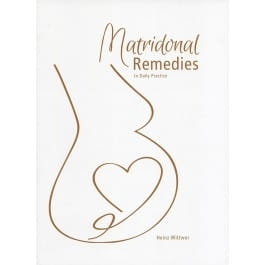MATRIDONAL REMEDIES – a door to new therapeutic possibilities
The life of a human being does not begin just at birth, but already at conception. A foetus experiences everything that is happening to its mother during pregnancy.
The state of the pregnant mother is continuously transferred onto the foetus, and moulds its intrauterine experiences. In the situation when during that time serious
events occurred, they can be the cause of disturbances in the person’s state of being even in adulthood. The so-called Matridonal Remedies are extremely well suited to resolve difficulties which arise during pregnancy or birth.
Matridonal Remedies are homoeopathic medicines, which have been made from human bodily tissues which relate to Pregnancy, Birth and Breastfeeding:
Amnii liquor - Amniotic Fluid
Chorda umbilicalis - Umbilical Chord
Placenta humana - Placenta
Vernix caseosa - Waxy covering with which the baby is born
Oxytocinum - Hormone inducing contractions and the let-down of breast milk
Lac maternum - Mother’s milk with Colostrum
Lac humanum - Mother’s milk without Colostrum
At the beginning of the text all the attributes are described, from which one can conclude that there was some intrauterine disturbance. This is followed by a detailed description of the Matridonal Remedies, and finally their practical application is illustrated with more than thirty patient stories. A Matridonal Remedy Repertory at the end of the book helps one to find the indicated remedy.
A book from Practice for Practice
This book was printed according to the Cradle-to-Cradle®-Principle. All materials used, like paper, ink, etc. are 100% natural and are compostable, and can therefore safely be recycled and returned to the biological circulation.
Should the book be burned, no toxic gases will be produced, and the ash can be used as fertiliser.
The Cradle-to-Cradle-Principle is that whatever you create, you do it in an ecological way without using toxic substances. So, when the item is not used anymore, the materials can be reused to create something else.
- Author: Heinz Wittwer
- ISBN: 9783952509012
- 196 pages
- Paperback
- Printed in Switzerland
Reprinted with the permission of The Alliance of Registered Homeopaths (from 'Homeopathy in Practice' Journal, Autumn/Winter 2020 edition): Reviewed by Jo Kettaman MARH.
As a former midwife, I have always had a interest in the matridonal remedies - 'gifts from the mother' and yet I have also always struggled, if I'm honest, in deciding which one to prescribe. My previous reading of books and articles and attending presentations has left me seeing the themes of the group but not so much each individual remedy. This book goes a long way towards helping me with comparing and contrasting, and remedy selection.
The layout of the book is very straightforward which really helps to make it a practical tool for the practitioner. It starts with a description of the remedies that fall within this group and a timetable of remedies to consider in relation to events that occur in pregnancy. Folliculinum, which is included in the book, does not feature in the timetabling.
Wittwer states that is is usually not enough to prescribe just one matridonal remedy. The picture often changes after a successful prescription, and another matridonal remedy is required. He believes that generally, when Lac Humanum symptoms appear, it is a sign that matridonal treatment is complete. He then follows that statement with a proviso:
Occasionally it happens that, after a successful prescription of Lac humanum, again symptoms of a matridonal remedy arise in a patient. Then a further cycle of treatment begins which, like a winding staircase, will lead to the next level up.
The next chapter, on the general characteristics of the matridonal remedies, also includes a list of further reading on the general theme. This is followed by pictures of the individual matridonal remedies, again with accompanying references. The outline of each remedy is broken into sections highlighting the general matridonal themes. and then specific symptoms for the remedy. This is a bullet point section, so finding the symptoms is clear. For example, under Amniotic fluid there is a bullet heading, 'Sense of well-being in water', with three following points - desire to spend hours in the bath; desire to dive; 'water baby'.
Chapter 4 has a breakdown of remedy selection. This is really helpful and practical, almost like a flow chart:
- Matridonal yes or no? Does it have the themes?
- Which matridonal is indicated? Look at the timings chart as well as the individual remedy pictures.
- Prescriptions of follow-up remedy? Still need another matridonal or move to a general remedy?
- Prescription of a remedy from another remedy group due to an event that happened in pregnancy - eg ailments from shock, grief, etc?
After this are summaries of 33 successful prescriptions. Some of these cases had a single matridonal remedy, either just one dose or repeated doses and changes in potency, and some required different matridonal remedies, following the timetable of events. I found this section very helpful as it demonstrates that these remedies can be given in a multitude of ways. I have previously read statements that seem to infer certain matridonals should only be prescribed in a specific potency.
The book ends with a brief repertory section, which is helpful. I have tried using it with some cases over the last few weeks, while reviewing the book, and it definitely aided my remedy selection.
I am so pleased that this book has been written. It is a really useful addition to the current library of information about these special remedies.

